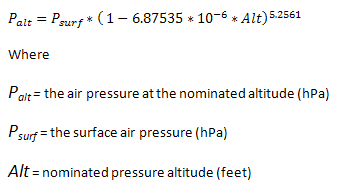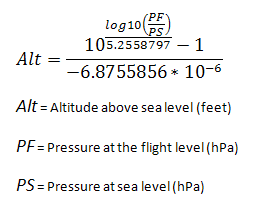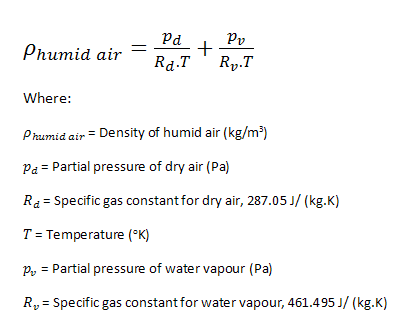

The hard part is actually filtering out transients due to wind, sunlight falling on the pressure sensor, and the violent motions that occur especially at the ejection event which cause both mechanical stress on the sensor and transients in the static pressure wherever it is located. This seems pretty inflexible to me-do you always fly from exactly the same spot?-rather than doing as others do. Your approach requires that wherever you fly you actually do know the launch site elevation (exactly where your pad is, as well as how far above the ground the rocket is on the pad), which you said earlier was hard coded. As Cris noted, the assumption is that over the duration of a flight, this is close enough. They all, as far as I know, assume the standard atmosphere and store a local altitude based on it just before launch and treat this as ground level, then use the SAM in turn as reference for subsequent heights based on subsequent pressure measurements, as I mentioned before. Yo3ict (interesting screen name, are you in Wichita?): I am a user of altimeters, not one who writes the software, so I can't comment on the specifics of algorithms.

But the barometer also senses the air at the avionics temperature. My baro sensor has a temp sensor as well, but it is located deep inside the avionics bay, so it senses the avionics temperature. Now, would applying the forecasted launch site temperature can improve the precision?

Of course, calculating the sea level pressure involves the SAM, but the results are spot-on with the online data and with a Garmin altimeter-capable smartwatch. My altimeter calculates by itself the launch site sea level pressure, by knowing two things : the launch site elevation and the launch site pressure. Is this a flawed approach?īEC, cerving : Could you be more specific about the algorithm? I use it afterwards instead of the SAM's 1013.25. The formula is correct, and at first I apply it backwards, knowing the launch site pressure and altitude, to get the sea level pressure. UhClem, rocket_troy : Calculus as calculation, not as derivatives or integrals.īuckeye : Right, but that involves sounding data. If I am using the standard atmosphere model's 15C, then someone might legitimately argue why I'm not also using the standard atmosphere model's sea level pressure. My barometric sensor also measures temperature, but it is the electronics temperature, not the environment. What temperature to use in my calculations? , where many of the hardcoded numbers are coming from different parameters of the standard atmosphere model like the temperature lapse rate, universal gas constant, molar mass, etc. Then, with the known sea level pressure, I get the actual vehicle altitude during the flight with the backwards formula:Īltitude = -(273+Temperature) / 0.0065 * On my flight computer, I use the hardcoded launch site altitude and the current barometric pressure to determine the sea level barometric pressure with the formula:Ĭurrent pressure = Sea level pressure / ^5.256 It directly impacts an airplane’s ability to fly effectively.To all the nerds out ying to figure out what is the general consensus in regards to getting the altitude from the pressure data. Pilots need to know the density altitude to operate aircraft safely during flight. This is due to the fact that air density decreases at higher altitudes. For example, if the density altitude is 5,000 feet at sea level, your airplane is going to take off like it’s already flying at 5,000 feet. What Is Density Altitude?ĭensity altitude is formally defined as the “pressure altitude corrected for nonstandard temperature variations.” That’s just a fancy way of saying density altitude is where the airplane “feels” like it is.
Pressure altitude formula how to#
Here are quick and easy tips on how to determine density altitude. Awareness of the density altitude will help you maintain a realistic perspective of the performance capabilities of your aircraft at all times. It can also affect the distance needed to land safely. Specifically, a high-density altitude can impact aircraft performance during takeoff and climb. Airplanes simply cannot perform as effectively in low-density air, potentially putting pilots, passengers, and other aircraft at risk. Learning how to accurately determine the density altitude is a critical skill that all pilots must master to fly safely.


 0 kommentar(er)
0 kommentar(er)
